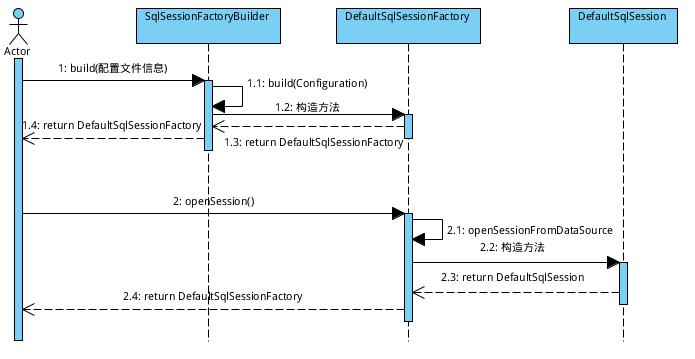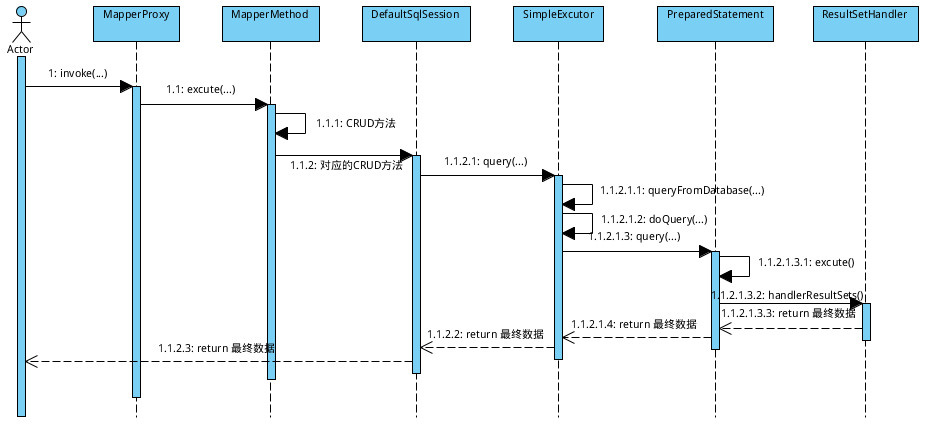深入浅出Mybatis系列(十)---SQL执行流程分析(源码篇)
最近太忙了,一直没时间继续更新博客,今天忙里偷闲继续我的Mybatis学习之旅。在前九篇中,介绍了mybatis的配置以及使用, 那么本篇将走进mybatis的源码,分析mybatis 的执行流程, 好啦,鄙人不喜欢口水话,还是直接上干活吧:
1. SqlSessionFactory 与 SqlSession.
通过前面的章节对于mybatis 的介绍及使用,大家都能体会到SqlSession的重要性了吧, 没错,从表面上来看,咱们都是通过SqlSession去执行sql语句(注意:是从表面看,实际的待会儿就会讲)。那么咱们就先看看是怎么获取SqlSession的吧:

(1)首先,SqlSessionFactoryBuilder去读取mybatis的配置文件,然后build一个DefaultSqlSessionFactory。源码如下:
/**
* 一系列的构造方法最终都会调用本方法(配置文件为Reader时会调用本方法,还有一个InputStream方法与此对应)
* @param reader
* @param environment
* @param properties
* @return
*/
public SqlSessionFactory build(Reader reader, String environment, Properties properties) {
try {
//通过XMLConfigBuilder解析配置文件,解析的配置相关信息都会封装为一个Configuration对象
XMLConfigBuilder parser = new XMLConfigBuilder(reader, environment, properties);
//这儿创建DefaultSessionFactory对象
return build(parser.parse());
} catch (Exception e) {
throw ExceptionFactory.wrapException("Error building SqlSession.", e);
} finally {
ErrorContext.instance().reset();
try {
reader.close();
} catch (IOException e) {
// Intentionally ignore. Prefer previous error.
}
}
} public SqlSessionFactory build(Configuration config) {
return new DefaultSqlSessionFactory(config);
}
(2)当我们获取到SqlSessionFactory之后,就可以通过SqlSessionFactory去获取SqlSession对象。源码如下:
/**
* 通常一系列openSession方法最终都会调用本方法
* @param execType
* @param level
* @param autoCommit
* @return
*/
private SqlSession openSessionFromDataSource(ExecutorType execType, TransactionIsolationLevel level, boolean autoCommit) {
Transaction tx = null;
try {
//通过Confuguration对象去获取Mybatis相关配置信息, Environment对象包含了数据源和事务的配置
final Environment environment = configuration.getEnvironment();
final TransactionFactory transactionFactory = getTransactionFactoryFromEnvironment(environment);
tx = transactionFactory.newTransaction(environment.getDataSource(), level, autoCommit);
//之前说了,从表面上来看,咱们是用sqlSession在执行sql语句, 实际呢,其实是通过excutor执行, excutor是对于Statement的封装
final Executor executor = configuration.newExecutor(tx, execType);
//关键看这儿,创建了一个DefaultSqlSession对象
return new DefaultSqlSession(configuration, executor, autoCommit);
} catch (Exception e) {
closeTransaction(tx); // may have fetched a connection so lets call close()
throw ExceptionFactory.wrapException("Error opening session. Cause: " + e, e);
} finally {
ErrorContext.instance().reset();
}
}
通过以上步骤,咱们已经得到SqlSession对象了。接下来就是该干嘛干嘛去了(话说还能干嘛,当然是执行sql语句咯)。看了上面,咱们也回想一下之前写的Demo,
SqlSessionFactory sessionFactory = null;
String resource = "mybatis-conf.xml";
try {
//SqlSessionFactoryBuilder读取配置文件
sessionFactory = new SqlSessionFactoryBuilder().build(Resources
.getResourceAsReader(resource));
} catch (IOException e) {
e.printStackTrace();
}
//通过SqlSessionFactory获取SqlSession
SqlSession sqlSession = sessionFactory.openSession();
还真这么一回事儿,对吧!
SqlSession咱们也拿到了,咱们可以调用SqlSession中一系列的select..., insert..., update..., delete...方法轻松自如的进行CRUD操作了。 就这样? 那咱配置的映射文件去哪儿了? 别急, 咱们接着往下看:
2. 利器之MapperProxy:

在mybatis中,通过MapperProxy动态代理咱们的dao, 也就是说, 当咱们执行自己写的dao里面的方法的时候,其实是对应的mapperProxy在代理。那么,咱们就看看怎么获取MapperProxy对象吧:
(1)通过SqlSession从Configuration中获取。源码如下:
/**
* 什么都不做,直接去configuration中找, 哥就是这么任性
*/
@Override
public <T> T getMapper(Class<T> type) {
return configuration.<T>getMapper(type, this);
}
(2)SqlSession把包袱甩给了Configuration, 接下来就看看Configuration。源码如下:
/**
* 烫手的山芋,俺不要,你找mapperRegistry去要
* @param type
* @param sqlSession
* @return
*/
public <T> T getMapper(Class<T> type, SqlSession sqlSession) {
return mapperRegistry.getMapper(type, sqlSession);
}
(3)Configuration不要这烫手的山芋,接着甩给了MapperRegistry, 那咱看看MapperRegistry。 源码如下:
/**
* 烂活净让我来做了,没法了,下面没人了,我不做谁来做
* @param type
* @param sqlSession
* @return
*/
@SuppressWarnings("unchecked")
public <T> T getMapper(Class<T> type, SqlSession sqlSession) {
//能偷懒的就偷懒,俺把粗活交给MapperProxyFactory去做
final MapperProxyFactory<T> mapperProxyFactory = (MapperProxyFactory<T>) knownMappers.get(type);
if (mapperProxyFactory == null) {
throw new BindingException("Type " + type + " is not known to the MapperRegistry.");
}
try {
//关键在这儿
return mapperProxyFactory.newInstance(sqlSession);
} catch (Exception e) {
throw new BindingException("Error getting mapper instance. Cause: " + e, e);
}
}
(4)MapperProxyFactory是个苦B的人,粗活最终交给它去做了。咱们看看源码:
/**
* 别人虐我千百遍,我待别人如初恋
* @param mapperProxy
* @return
*/
@SuppressWarnings("unchecked")
protected T newInstance(MapperProxy<T> mapperProxy) {
//动态代理我们写的dao接口
return (T) Proxy.newProxyInstance(mapperInterface.getClassLoader(), new Class[] { mapperInterface }, mapperProxy);
} public T newInstance(SqlSession sqlSession) {
final MapperProxy<T> mapperProxy = new MapperProxy<T>(sqlSession, mapperInterface, methodCache);
return newInstance(mapperProxy);
}
通过以上的动态代理,咱们就可以方便地使用dao接口啦, 就像之前咱们写的demo那样:
UserDao userMapper = sqlSession.getMapper(UserDao.class);
User insertUser = new User();
这下方便多了吧, 呵呵, 貌似mybatis的源码就这么一回事儿啊。
别急,还没完, 咱们还没看具体是怎么执行sql语句的呢。
3. Excutor:

接下来,咱们才要真正去看sql的执行过程了。
上面,咱们拿到了MapperProxy, 每个MapperProxy对应一个dao接口, 那么咱们在使用的时候,MapperProxy是怎么做的呢? 源码奉上:
MapperProxy:
/**
* MapperProxy在执行时会触发此方法
*/
@Override
public Object invoke(Object proxy, Method method, Object[] args) throws Throwable {
if (Object.class.equals(method.getDeclaringClass())) {
try {
return method.invoke(this, args);
} catch (Throwable t) {
throw ExceptionUtil.unwrapThrowable(t);
}
}
final MapperMethod mapperMethod = cachedMapperMethod(method);
//二话不说,主要交给MapperMethod自己去管
return mapperMethod.execute(sqlSession, args);
}
MapperMethod:
/**
* 看着代码不少,不过其实就是先判断CRUD类型,然后根据类型去选择到底执行sqlSession中的哪个方法,绕了一圈,又转回sqlSession了
* @param sqlSession
* @param args
* @return
*/
public Object execute(SqlSession sqlSession, Object[] args) {
Object result;
if (SqlCommandType.INSERT == command.getType()) {
Object param = method.convertArgsToSqlCommandParam(args);
result = rowCountResult(sqlSession.insert(command.getName(), param));
} else if (SqlCommandType.UPDATE == command.getType()) {
Object param = method.convertArgsToSqlCommandParam(args);
result = rowCountResult(sqlSession.update(command.getName(), param));
} else if (SqlCommandType.DELETE == command.getType()) {
Object param = method.convertArgsToSqlCommandParam(args);
result = rowCountResult(sqlSession.delete(command.getName(), param));
} else if (SqlCommandType.SELECT == command.getType()) {
if (method.returnsVoid() && method.hasResultHandler()) {
executeWithResultHandler(sqlSession, args);
result = null;
} else if (method.returnsMany()) {
result = executeForMany(sqlSession, args);
} else if (method.returnsMap()) {
result = executeForMap(sqlSession, args);
} else {
Object param = method.convertArgsToSqlCommandParam(args);
result = sqlSession.selectOne(command.getName(), param);
}
} else {
throw new BindingException("Unknown execution method for: " + command.getName());
}
if (result == null && method.getReturnType().isPrimitive() && !method.returnsVoid()) {
throw new BindingException("Mapper method '" + command.getName()
+ " attempted to return null from a method with a primitive return type (" + method.getReturnType() + ").");
}
return result;
}
既然又回到SqlSession了, 那么咱们就看看SqlSession的CRUD方法了,为了省事,还是就选择其中的一个方法来做分析吧。这儿,咱们选择了selectList方法:
public <E> List<E> selectList(String statement, Object parameter, RowBounds rowBounds) {
try {
MappedStatement ms = configuration.getMappedStatement(statement);
//CRUD实际上是交给Excetor去处理, excutor其实也只是穿了个马甲而已,小样,别以为穿个马甲我就不认识你嘞!
return executor.query(ms, wrapCollection(parameter), rowBounds, Executor.NO_RESULT_HANDLER);
} catch (Exception e) {
throw ExceptionFactory.wrapException("Error querying database. Cause: " + e, e);
} finally {
ErrorContext.instance().reset();
}
}
然后,通过一层一层的调用,最终会来到doQuery方法, 这儿咱们就随便找个Excutor看看doQuery方法的实现吧,我这儿选择了SimpleExecutor:
public <E> List<E> doQuery(MappedStatement ms, Object parameter, RowBounds rowBounds, ResultHandler resultHandler, BoundSql boundSql) throws SQLException {
Statement stmt = null;
try {
Configuration configuration = ms.getConfiguration();
StatementHandler handler = configuration.newStatementHandler(wrapper, ms, parameter, rowBounds, resultHandler, boundSql);
stmt = prepareStatement(handler, ms.getStatementLog());
//StatementHandler封装了Statement, 让 StatementHandler 去处理
return handler.<E>query(stmt, resultHandler);
} finally {
closeStatement(stmt);
}
}
接下来,咱们看看StatementHandler 的一个实现类 PreparedStatementHandler(这也是我们最常用的,封装的是PreparedStatement), 看看它使怎么去处理的:
public <E> List<E> query(Statement statement, ResultHandler resultHandler) throws SQLException {
//到此,原形毕露, PreparedStatement, 这个大家都已经滚瓜烂熟了吧
PreparedStatement ps = (PreparedStatement) statement;
ps.execute();
//结果交给了ResultSetHandler 去处理
return resultSetHandler.<E> handleResultSets(ps);
}
到此, 一次sql的执行流程就完了。 我这儿仅抛砖引玉,建议有兴趣的去看看Mybatis3的源码。
好啦,本次就到此结束啦,最近太忙了, 又该忙去啦。
深入浅出Mybatis系列(十)---SQL执行流程分析(源码篇)的更多相关文章
- 深入浅出Mybatis系列十-SQL执行流程分析(源码篇)
注:本文转载自南轲梦 注:博主 Chloneda:个人博客 | 博客园 | Github | Gitee | 知乎 最近太忙了,一直没时间继续更新博客,今天忙里偷闲继续我的Mybatis学习之旅.在前 ...
- Hive SQL执行流程分析
转自 http://www.tuicool.com/articles/qyUzQj 最近在研究Impala,还是先回顾下Hive的SQL执行流程吧. Hive有三种用户接口: cli (Command ...
- SpringMVC执行流程及源码分析
SpringMVC流程及源码分析 前言 学了一遍SpringMVC以后,想着做一个总结,复习一下.复习写下面的总结的时候才发现,其实自己学的并不彻底.牢固.也没有学全,视频跟书本是要结合起来一起, ...
- django Rest Framework----APIView 执行流程 APIView 源码分析
在django—CBV源码分析中,我们是分析的from django.views import View下的执行流程,这篇博客我们介绍django Rest Framework下的APIView的源码 ...
- Django 基于类的视图(CBV)执行流程 CBV 源码分析
一.CBV(基于类的视图) 视图是可以调用的,它接受请求并返回响应,这不仅仅是一个函数,Django提供了一些可以用作视图的类的例子,这些允许您通过继承或mixin来构建视图并重用代码. 基本示例 D ...
- Struts流程分析+源码分析
1.初始化工作 读取配置---转换器-----读取插件 当struts-config.xml配置文件加载到内存,则会创建两个map:ActionConfigs,FromBeans.这两个map都交由M ...
- 深入浅出Mybatis系列(九)---强大的动态SQL
上篇文章<深入浅出Mybatis系列(八)---mapper映射文件配置之select.resultMap>简单介绍了mybatis的查询,至此,CRUD都已讲完.本文将介绍mybatis ...
- 深入浅出Mybatis系列(九)---强大的动态SQL(转载)
原文出处:http://www.cnblogs.com/dongying/p/4092662.html 上篇文章<深入浅出Mybatis系列(八)---mapper映射文件配置之select.r ...
- 深入浅出Mybatis系列九-强大的动态SQL
注:本文转载自南轲梦 注:博主 Chloneda:个人博客 | 博客园 | Github | Gitee | 知乎 上篇文章<深入浅出Mybatis系列(八)---mapper映射文件配置之se ...
随机推荐
- sql server常用语法点
if exists(select name from sysobjects where name = 'stuInfo')drop table stuInfogocreate table stuInf ...
- linq+映射数据库调用方法
关于这一块.我在网上了解了很多.但是都没有找到自己想要的.通过各方面了解在linq 中调用映射的数据库函数以及存储过程方法如下. 1.传递对象参数//*注意:参数必须和你函数或者存储过程的参数一样 ...
- https 单向认证和双向认证配置
HTTPS 是我们开发中经常用到的通信加密技术,能有效保护我们网络访问中的安全,本文主要讲解单向 和 双向 https 的配置.关于https 的实现原理在这里我就不赘述了,附上阮一峰老师的关于htt ...
- (转)sqlplus中文显示乱码的问题
sqlplus中文显示乱码的问题 2010-07-19 11:33:26 分类: LINUX 在windows下sqlplus完全正常,可是到linux下,sqlplus中文显示就出问题了,总是显示“ ...
- widgets、dialogs与自动连接(auto-connect)
QMetaObject的自动连接设施(auto-connect facilities)可以自动将槽与信号连接起来,只需要声明和定义一个符合标准命名规则的槽函数 void on_<object n ...
- 读《编写可维护的JavaScript》第11章总结
这周也是拿到了同程的offer,从此走上了前端之路!感谢我的贵人们.再次纪念一下~! 第11章 不是你的对象不要动 11.1 什么是你的 你的对象:当你的代码创建了这些对象或者你有职责维护其他人的代码 ...
- Tomcat内部结构及工作原理学习
Tomcat原本是Servlet/JSP的一个调试工具,后来才发展为一个Servlet/JSP的容器. Tomcat作为Servlet容器,负责处理客户请求,把请求传送给Servlet并把结果返回给客 ...
- Latex引用插图格式制定问题(1)
自定义新命令\reffig如下:\newcommand{\reffig}[1]{Figure \ref{#1}}在需要引用图片的时候,用\reffig代替\ref,就可以自动在图号前面输出" ...
- css实现div的高度填满剩余空间
css实现div的高度填满剩余空间 .top{ width: 100%; height: 70px;} .bottom{background-color: #cc85d9;width: 100%;po ...
- 新手用git
最近几天用到了git,作为只看过教程,没有在实际项目中使用过的人来说,简直是 T_T ...... 在这里记录一下,以防以后忘记. clone : 本地没有该库,从远程repository拷贝到本地 ...
